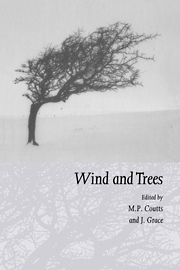Book contents
- Frontmatter
- Contents
- Preface
- List of contributors
- Part I Airflow over topography and in forests
- 1 Turbulent airflow in forests on flat and hilly terrain
- 2 The interactions of wind and tree movement in forest canopies
- 3 Edge effects on diffusivity in the roughness layer over a forest
- 4 A wind tunnel study of turbulent airflow in forest clearcuts
- 5 Testing of a linear airflow model for flow over complex terrain and subject to stable, structured stratification
- 6 Predicting windspeeds for forest areas in complex terrain
- Part II Mechanics of trees under wind loading
- Part III Tree physiological responses
- Part IV Impacts of wind on forests and ecology
- Part V Risk assessment and management response
- Index
5 - Testing of a linear airflow model for flow over complex terrain and subject to stable, structured stratification
Published online by Cambridge University Press: 27 October 2009
- Frontmatter
- Contents
- Preface
- List of contributors
- Part I Airflow over topography and in forests
- 1 Turbulent airflow in forests on flat and hilly terrain
- 2 The interactions of wind and tree movement in forest canopies
- 3 Edge effects on diffusivity in the roughness layer over a forest
- 4 A wind tunnel study of turbulent airflow in forest clearcuts
- 5 Testing of a linear airflow model for flow over complex terrain and subject to stable, structured stratification
- 6 Predicting windspeeds for forest areas in complex terrain
- Part II Mechanics of trees under wind loading
- Part III Tree physiological responses
- Part IV Impacts of wind on forests and ecology
- Part V Risk assessment and management response
- Index
Summary
Abstract
The model (Flowstar) is tested against new airflow data from a region of complex terrain and roughness cover (Kintyre, south-west Scotland). The dataset consists of mean flow data at 10 m above the surface at up to 14 sites supported by airborne measurements of the upstream temperature profile and the flow aloft. The structured, stable stratification is shown to exert a strong influence on the mean flow close to the surface. Far from the surface Flowstar reproduces the main features of the stratification-dependent flow. However, additional Flowstar stratification options may improve the model in cases where the upstream profile is complicated. At 10 m above the surface and in near-neutral conditions the reliability of Flowstar predictions of mean flow are comparable with those from similar models applied to simpler terrain shapes. Errors are observed in wake regions where the model overpredicts windspeeds. This is due to a previously known limitation of linear models. Flowstar modelling of the effects of stable stratification on the mean flow at 10 m is encouraging, although some dependence of accuracy on stratification type is noted. Recommendations for the use of Flowstar in practical applications are made.
Introduction
In many areas of the United Kingdom the wind climate is the limiting factor to forest growth (Cannell & Coutts, 1988). A model of wind flow over complex terrain (i.e. terrain that does not approximate to any simple shape) would help foresters to plan planting patterns to minimise damage. Such a model must be adaptable enough to represent a wide range of realistic conditions and accurate enough to allow confident forest planning.
- Type
- Chapter
- Information
- Wind and Trees , pp. 88 - 112Publisher: Cambridge University PressPrint publication year: 1995
- 4
- Cited by



